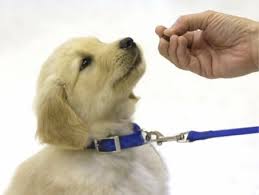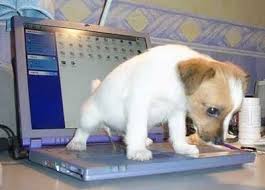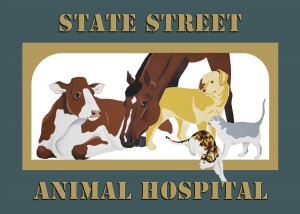Reason #1 for scheduling your pet’s dental: Yuck, dog breath!
Bacteria in the mouth cause infection and odor. Nobody enjoys putrid dog breath or smelly kitty kisses. Keeping those teeth clean means a happier, healthier relationship for everyone.
Reason #2 for scheduling your pet’s dental: Clean teeth help keep the whole body healthy.
The bacteria that cause awful breath and gingivitis can also enter the blood stream and cause infection in other organs, such as the heart valves (endocarditis) and kidneys (pyelonephritis). Keeping those teeth clean helps the whole body stay healthy.
Reason #3 for scheduling your pet’s dental: infected teeth hurt.
If you’ve ever had a toothache, you know—if you haven’t had one, trust us, you don’t want one. Chronic pain can make animals less sociable. We’ve had several cases where owner’s have mentioned how much happier, friendlier or more active their cat became after the dental.
Reason #4 for scheduling your pet’s dental: save those teeth. We would rather save teeth than remove them.
If we can get the tartar off before the tooth root is damaged we can save the tooth. Once the root is infected and the tooth is loose we have to pull it to eliminate a source of constant pain and infection. Early intervention is key to preserving healthy teeth.
Reason #5 for scheduling your pet’s dental: Save money in the long run!
Dental disease is a source of chronic bacterial exposure to other organs in the body leading to infections, which need medical care. Painful teeth effect how an animal eats and digests potentially effecting weight and gastrointestinal health. Chronic dental problems lead to more teeth needing to be extracted and greater expense when a dental is done—so, keeping teeth healthy in the long run is a good investment in overall health.
February is Pet Dental Health Month. We want to encourage people to have their pets’ teeth cleaned and cared for. Therefore we will be offering a 20% discount on all dentals scheduled during the month of February.
 If you use treats to train a dog, you will always need them to get the dog to obey your commands.
If you use treats to train a dog, you will always need them to get the dog to obey your commands.
The principles that govern the laws of learning have shown this to be completely untrue. Treats are an excellent means o reinforcing a behavior. Clear and consistent reinforcement is necessary when you initially begin teaching any animal a new behavior. For some animals, a vocal reward, toys, or petting may serve as good reinforcers, but food is for many animals the most salient reinforcement there is. The rules of learning show that when first teaching a new behavior, reinforcing every singe time the behavior is performed on cue will lead to the fastest rate of learning. Once a behavior is learned, intermittent reinforcement is the best means of maintaining the behavior and making it most resistant to extinction. This means that you only have to use the treats periodically once the behavior is learned.
People who believe that an animal is not responding because it knows there is no treat available have usually failed to use reinforcement appropriately or don’t realize that the animal has actually not learned the behavior. It is common for pet owners to think that an animal has learned a command long before it actually has.
FACT: When used correctly, positive reinforcement training with food rewards is far more likely to be effective and has less chance of doing harm than most other forms of training.
 I’m embarrassed to talk to my veterinarian about my pet’s behavior. I’m afraid that I’m the problem!
I’m embarrassed to talk to my veterinarian about my pet’s behavior. I’m afraid that I’m the problem!
A variety of factors play a role in the development of behavior problems, including a pet’s genetics, early experiences, and environment. While you can certainly worsen a pet’s behavior problem with inappropriate training methods, it is highly unlikely that you caused your pet’s behavior problems. Many medical conditions and medications can also contribute to behavior changes, so your veterinarian is the best person to consult first when your pet exhibits worrisome behaviors.
FACT: Don’t hesitate to ask your veterinarian about any problem that may affect your pet’s health and well-being. Most behavior problems are at least manageable-if not always curable. But the sooner you seek qualified advice, the higher the likelihood you can successfully treat the problem.
A Cat Owner’s List of Tips for Less Stress on the Way to the Vets:
An excellent web video called “Cat Carriers: Friend not Foe” is available which demonstrates the recommendations listed below. Please feel free to use this link to see the site: www.catalystcouncil.org/resources/health_welfare/cat_carrier_video/
Step 1)
Choose a good carrier:
An ideal carrier is safe, easy to clean, easy to get your cat into and out of, and a reasonable size for you to carry. Many an injury can occur when a frightened cat jumps out of an owner’s arm, or is loose in the car during a sudden stop. Carriers that can be opened from the top, a side or that can be easily taken apart and re-assembled work very well. Plastic carriers are easy to clean, which is especially important if a cat has urinated or vomits during the trip. Soft cloth carriers are harder to clean but more comfortable for some cats. A good carrier can be a safe, and even comforting place for the carrier trained cat.
Step 2)
Making the carrier a welcome den for your kitty:
Many people store their cat carrier in the closet or basement and get it out when it is time for that yearly trip to the veterinarian. As a result, the kitty hides when is sees the carrier. The carrier also may smell strange from being stored, and from previous trips during which the cat felt nervous. To help alleviate some stress find that carrier, clean it up and place a nice comforting towel or a piece of clothing from the cat’s favorite person in it. Put the carrier in a place where the kitty often relaxes or sleeps and leave it there with the door open, inviting the cat to rest or play in it. For particularly nervous cats, enticing them to enter the carrier with treats or play can really help. If the carrier is a regular and safe part of the kitty’s life it won’t seem scary when it is time to ride to the veterinary office.
Step 3)
Getting ready for a ride:
Once your cat is used to being in and around the carrier, we need to get her used to the sounds the carrier makes when the door is opened or closed, and the feeling of being picked up and moved. Exercises at home prior to the vet visit can help. Make sure to minimize shifting and bumping when the carrier is carried. (This is why you should avoid getting a carrier bigger than you can comfortably handle.)
Step 4)
Getting used to the car ride:
Some cats feel more comfortable with a blanket or towel draped over the carrier for rides.
Bringing the carrier to the car and getting the cat used to short drives can also help them prepare for future vet trips.
We need to try to make the journey in the car as smooth as possible. During cold weather, warm the car up prior to travel. In hot weather remember that closed cars heat up fast and heat stroke is a concern; so don’t leave pets in closed cars unattended for any length of time. Avoid loud music, and sudden accelerations or stops as much as safe driving allows.
Step 5)
Minimizing stress at the Veterinary Hospital
Try to sit at a distance from dogs in the office and keep a cover over the carrier if kitty is more nervous at the Veterinary office. If your cat is particularly anxious, ask to arrange an appointment during one of the quieter times at the clinic.
While it would be ideal for cats to visit the Veterinary office when it is calm and there are no dogs barking (especially true if the cats don’t live with dogs), that is not always possible. Most small animal practices don’t have the luxury of having a “cat only” area. In order to help our feline patients, State Street Animal Hospital, PC is trying out a “cats only” Wednesday appointment time once a month. Ask us about “Whisker Wednesday” if you would like to try this out to help your feline friend feel less stressed.
Christmas trees, Holly and Ivy, kissing under the mistletoe, bright red Poinsettias: holiday greens brighten up December.
Unfortunately some of these are risks to our pets. Houses can be decorated with some simple precautions. Poinsettia leaves contain sap, which is very irritating to the mouth and throat and can cause drooling and vomiting. Holly and mistletoe are both poisonous. Christmas trees are relatively low risk though the sap can irritate skin and get stuck in fur.
Then there are the ornaments on the tree. Tinsel and ribbon are very attractive to cats and if consumed can cause intestinal damage. Ornaments on the bottom of the tree should be safe and non-breakable. Electric cords should be protected from pets that chew everything—especially puppies!
Make sure trees are secured and cannot be easily knocked over. Supervise your pet around Christmas trees and keep the other greens out of reach.
The Staff and Veterinarians of State Street Animal Hospital, PC wish you a happy, healthy holiday season.


 If you use treats to train a dog, you will always need them to get the dog to obey your commands.
If you use treats to train a dog, you will always need them to get the dog to obey your commands. I’m embarrassed to talk to my veterinarian about my pet’s behavior. I’m afraid that I’m the problem!
I’m embarrassed to talk to my veterinarian about my pet’s behavior. I’m afraid that I’m the problem!










Social